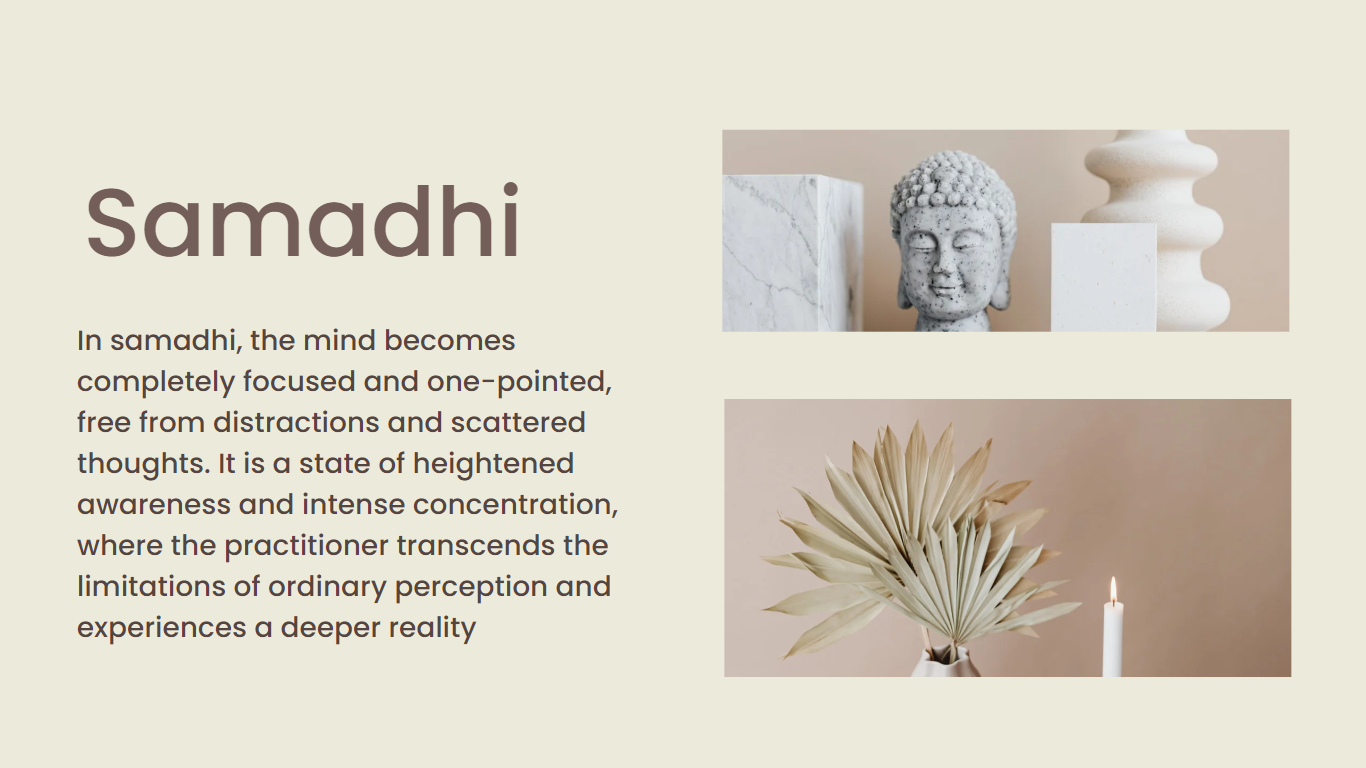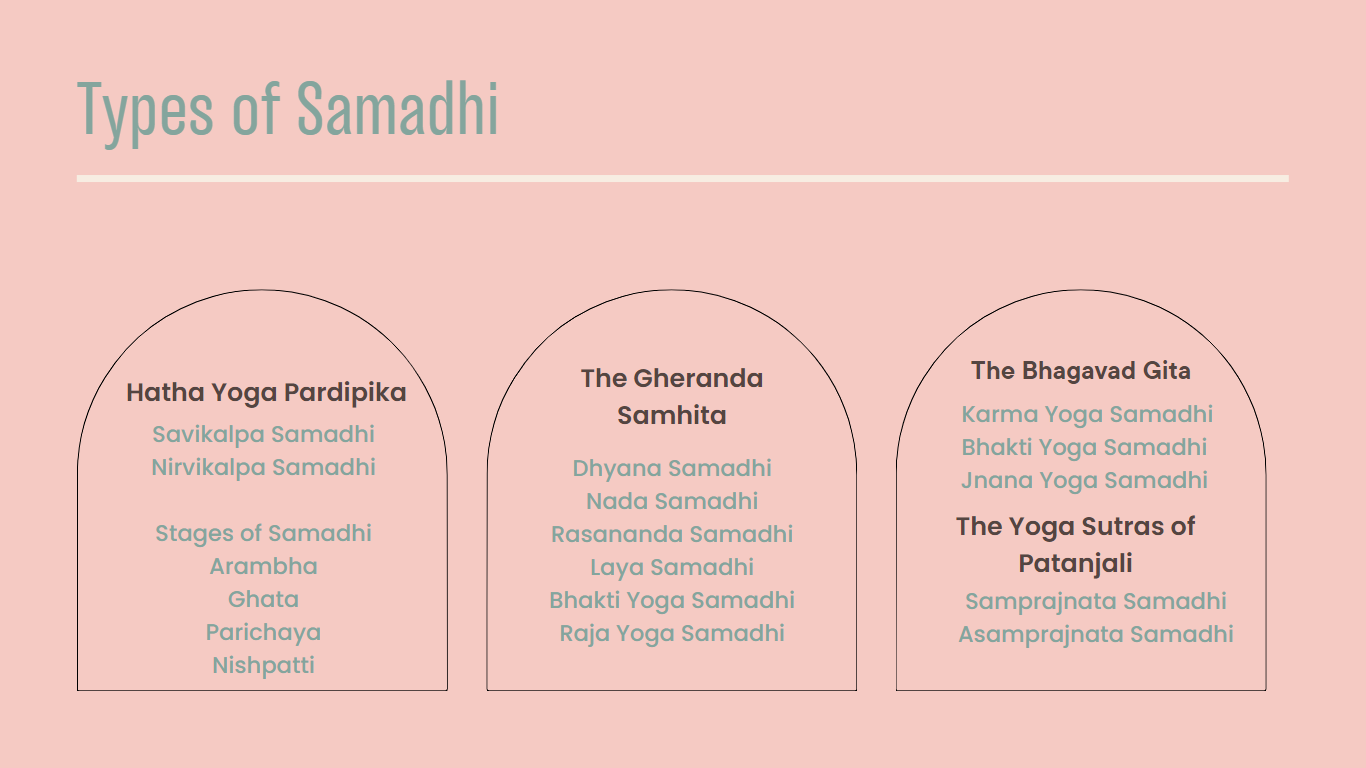What is Samadhi and how to get to Samadhi?
To begin with, it is important to go over the meaning of Samadhi in the practice of Yoga. What does the scripture say about the term, and how can we apply the practice of Yoga in our quest to achieve enlightenment?
In other words, how can we achieve moksha? What are the steps to liberate our senses in the material world?
We will explore these questions but first, let's start with the definition of Samadhi and the various ways in which each yogic scripture explains this term in all its splendor.
Samadhi
It is defined as the final stage in which the union with the supreme power is realized. It is through deep meditative concentration that this union is ultimately achieved.
In other words, it is a state of profound meditation where one experiences complete contemplation of the absolute, undisturbed by the senses, desires, anger, and ego-generated thoughts.
It is said that during this state, the ego disappears and the individual achieves oneness with the divine. We can also describe Samadhi as the attainment of the highest stage in meditation, where the wheel of thoughts comes to a halt and the mind becomes unified with the cosmic.

Now let's delve deeper into the meaning of each Samadhi in relation to the respective texts.
In the Hatha Yoga Pradipika, Swami Svatmarama discusses Samadhi in the context of "Nada" yoga, which focuses on the inner sound or vibration heard during meditation. He explains that the sound "Nada" represents the cosmic vibration that leads to higher consciousness. Swami Svatmarama suggests that yoga practitioners should experience the four states of Nada to attain higher states of consciousness, resulting in inner peace and bliss, ultimately leading to liberation or the state of Samadhi.
Furthermore, the text highlights the topic of Kundalini and establishes a connection between Kundalini and Samadhi. It is believed that once the Kundalini energy within us awakens, the state of higher consciousness is finally achieved. Swami Svatmarama discusses various methods to awaken our primal energy, Kundalini, which resides at the base of our spine. The remedies listed include innate Kundalini, mantra, penance, herbal awakening, Raja Yoga sadhana, pranayama, kriya, tantrik diksha, shaktipat, and ultimately surrender.
Stages of Samadhi
Moreover, Swami Svatmarama discusses the several stages of Samadhi, each involving different levels of concentration and absorption. The first stage is called dharana, which refers to the ability to focus the mind on a specific object or point. The second stage is dhyana, where the mind becomes completely absorbed in meditation. The third and final stage is known as samadhi proper, where the individual is fully immersed in oneness during the meditation.
Types of Samadhi
Swami Svatmarama also explains the two types of Samadhi. The first is savikalpa, where no further mental activity is required, and one simply maintains focus. The second is nirvikalpa, where there is no longer any focus, and the practitioner becomes one with the state of meditation or consciousness.
The Hatha Yoga Pradipika further elucidates that within the state of full consciousness, where the ego dissipates, the self merges with the divine.
Additional Stages of Samadhi | Hatha Yoga Pradipika
There are four additional stages: Arambha, where one hears a tinkling sound vibrating throughout the body; Ghata, resembling the sound of a kettle; Parichaya, characterized by the sound of drums; and Nishpatti, which is achieved through the Nada discussed earlier. In Nishpatti, all sounds merge with the mind, and the yogi remains unaffected and unattached to any sensory experiences. At this moment, the yogi is completely liberated from all and impervious to harm.
Now, let's delve into the meaning of Samadhi and the requirements explained in the Gheranda Samhita. The text provides insights into the path of yoga and the practices one should follow to attain the state of Samadhi.
Gheranda highlights the eight limbs, also known as Ashtanga Yoga, that need to be followed.
These limbs are: Yama (social rules), Niyama (internal observance), Asana (posture), Pranayama (breathing), Pratyahara (turning inward), Dharana (concentration), Dhyana (meditation and letting go), and finally Samadhi (pure bliss).
Additionally, Gheranda mentions the seven limbs that contribute to attaining complete enlightenment.
These include two additional stages: Shatkarma, which involves cleansing practices to remove toxins from the body, and Mudra, which involves using gestures to control the flow of prana in the body. These practices, combined with the eight limbs, form a comprehensive approach to reaching the state of Samadhi.
Six different types of Samadhi by Sage Gheranda
It is important to mention that Sage Gheranda discusses the six different types of Samadhi that enable individuals to attain oneness with the supreme.
These types are as follows:
Dhyana Samadhi: By bringing the eyes to the third eye in a meditative state.
Nada Samadhi: Focusing on the inner sound, often compared to the buzzing of a bee.
Rasananda Samadhi: Experiencing the blissful taste through the practice of the Khechari mudra.
Laya Samadhi: Absorption in oneself as the divine, realizing the higher self, often associated with Lord Brahma.
Bhakti Yoga Samadhi: Engaging in contemplation of one's chosen deity as a form of devotion.
Raja Yoga Samadhi: Meditating with breath control and retention, known as kumbhaka.
These different types of Samadhi provide practitioners with various approaches to attaining the state of oneness with the supreme.
Top 3 essential secrets of life | the Bhagavad Gita
Samadhi is also emphasized as the state of complete absorption in the divine, and as the ultimate liberation, known as Moksha. The Bhagavad Gita imparts fundamental teachings on how to attain enlightenment by emphasizing three essential secrets of life.
The first secret is Karma Yoga, the path of selfless action.
The second secret is Bhakti Yoga, the path of devotion and love for the divine.
The third secret is Jnana Yoga, the path of knowledge and seeking the truth to understand one's true nature.
These three paths lead individuals toward the ultimate goal of reaching the state of Samadhi.
Concept of Samadhi | The Yoga Sutras of Patanjali
Finally, the Yoga Sutras of Patanjali discuss the concept of Samadhi.
The text is divided into four important chapters, with the first chapter focusing on the nature of Samadhi. This chapter holds significance as it highlights the essential aspects of achieving Samadhi and presents various techniques to overcome obstacles along the way. While there are 51 sutras in total, here we will focus on the concept of Chitta Vritti and how specific techniques can help calm the mind and attain the state of Samadhi.
Chitta is akin to our memory, where the subconscious resides, and it is composed of three parts: Manas, Buddhi, and Ahamkara. Each plays a distinct role in helping our Chitta establish a complete connection with the divine. To put it into perspective, we all have a mind that sometimes wanders, and we often feel like it is controlled by our senses. This is referred to as chitta vritis. Overcoming these chitta vritis is necessary for enlightenment. Realizing oneself, it means that the mind is finally at rest and no longer in a state of chitta vritis.
In other words, we are no longer affected by our imagination, misconceptions, or past experiences that hinder our quest for Samadhi. We are no longer impacted by stored emotions.
To gain control, we need abhyasa (consistent dedication), vairagya (detachment from desires), and the assistance of Bhakti Yoga.
Bhavna chatushtya (not judging others or having positive feelings towards happy people), practicing pranayama, and turning our senses inward (vishayavati parvritti) are also recommended. Additionally, allowing our thoughts to flow without attachment (jyotismati parvriti) is mentioned.
The Yoga Sutras of Patanjali also suggest meditating on our dreams to plant seeds in our minds and reduce fluctuations during nighttime. The text further mentions yathabimat dhyana, a tailored meditation practice for individuals to help them achieve Samadhi.

Throughout the yogic scriptures, Samadhi is presented as the ultimate state of realization and is considered the pinnacle of yogic philosophy. It serves as the ultimate goal that the various aspects of yoga, including asana practice, prepare us for. It is essential to recognize that yoga is not solely confined to the physical aspect but encompasses a holistic approach, with Samadhi being a crucial element in attaining liberation. By delving into the meanings and explanations of Samadhi in different texts such as the Hatha Yoga Pradipika, Gheranda Samhita, Bhagavad Gita, and Yoga Sutras of Patanjali, we gain a deeper understanding of its significance and the practices and techniques that can lead us towards this state of oneness with the divine. Samadhi represents the ultimate realization and transcendence of the mind, allowing us to overcome obstacles, still the fluctuations of the chitta, and ultimately experience pure bliss and liberation. By embracing the path of yoga, with Samadhi as the ultimate destination, we embark on a transformative journey of self-discovery and spiritual growth.
If you want to delve deeper into the ancient wisdom and practices that culminate in this state of blissful union, we invite you to join our 200 h Yoga teacher training in Bali or our 200 hour Yoga course in Germany.
In the serene landscapes of Bali or the calm setting in the North of the Eifel National Park in Germany, our immersive Yoga training provides the ideal environment to deepen your understanding of yoga and experience its transformative power. Led by experienced and certified yoga instructors, our best Yoga teacher training programs encompass a holistic curriculum, encompassing asanas (postures), pranayama (breathing techniques), meditation, philosophy, anatomy, and teaching methodology.
Whether you are a dedicated practitioner seeking to deepen your own practice or an aspiring teacher eager to share the wisdom of yoga with others, our 200 h Yoga teacher trainings are designed for all levels of experience.
This article was written by our student Sophia Racine during her 300 h Yoga course in Bali . You can contact her here for Yoga classes in Montreal.

